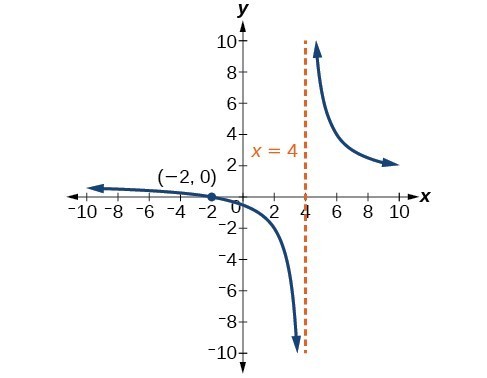Solutions
Solutions to Try Its
1. [latex]\left(2,\infty \right)[/latex] 2. [latex]\left(5,\infty \right)[/latex] 3. The domain is [latex]\left(0,\infty \right)[/latex], the range is [latex]\left(-\infty ,\infty \right)[/latex], and the vertical asymptote is x = 0. 4. The domain is [latex]\left(-4,\infty \right)[/latex], the range [latex]\left(-\infty ,\infty \right)[/latex], and the asymptote x = –4.
4. The domain is [latex]\left(-4,\infty \right)[/latex], the range [latex]\left(-\infty ,\infty \right)[/latex], and the asymptote x = –4.
 5. The domain is [latex]\left(0,\infty \right)[/latex], the range is [latex]\left(-\infty ,\infty \right)[/latex], and the vertical asymptote is x = 0.
5. The domain is [latex]\left(0,\infty \right)[/latex], the range is [latex]\left(-\infty ,\infty \right)[/latex], and the vertical asymptote is x = 0.
 6. The domain is [latex]\left(0,\infty \right)[/latex], the range is [latex]\left(-\infty ,\infty \right)[/latex], and the vertical asymptote is x = 0.
6. The domain is [latex]\left(0,\infty \right)[/latex], the range is [latex]\left(-\infty ,\infty \right)[/latex], and the vertical asymptote is x = 0.
 7. The domain is [latex]\left(2,\infty \right)[/latex], the range is [latex]\left(-\infty ,\infty \right)[/latex], and the vertical asymptote is x = 2.
7. The domain is [latex]\left(2,\infty \right)[/latex], the range is [latex]\left(-\infty ,\infty \right)[/latex], and the vertical asymptote is x = 2.


9. [latex]x\approx 3.049[/latex]
10. x = 1 11. [latex]f\left(x\right)=2\mathrm{ln}\left(x+3\right)-1[/latex]Solutions to Odd-Numbered Exercises
1. Since the functions are inverses, their graphs are mirror images about the line y = x. So for every point [latex]\left(a,b\right)[/latex] on the graph of a logarithmic function, there is a corresponding point [latex]\left(b,a\right)[/latex] on the graph of its inverse exponential function. 3. Shifting the function right or left and reflecting the function about the y-axis will affect its domain. 5. No. A horizontal asymptote would suggest a limit on the range, and the range of any logarithmic function in general form is all real numbers. 7. Domain: [latex]\left(-\infty ,\frac{1}{2}\right)[/latex]; Range: [latex]\left(-\infty ,\infty \right)[/latex] 9. Domain: [latex]\left(-\frac{17}{4},\infty \right)[/latex]; Range: [latex]\left(-\infty ,\infty \right)[/latex] 11. Domain: [latex]\left(5,\infty \right)[/latex]; Vertical asymptote: x = 5 13. Domain: [latex]\left(-\frac{1}{3},\infty \right)[/latex]; Vertical asymptote: [latex]x=-\frac{1}{3}[/latex] 15. Domain: [latex]\left(-3,\infty \right)[/latex]; Vertical asymptote: x = –3 17. Domain: [latex]\left(\frac{3}{7},\infty \right)[/latex]; Vertical asymptote: [latex]x=\frac{3}{7}[/latex] ; End behavior: as [latex]x\to {\left(\frac{3}{7}\right)}^{+},f\left(x\right)\to -\infty [/latex] and as [latex]x\to \infty ,f\left(x\right)\to \infty [/latex] 19. Domain: [latex]\left(-3,\infty \right)[/latex] ; Vertical asymptote: x = –3; End behavior: as [latex]x\to -{3}^{+}[/latex] , [latex]f\left(x\right)\to -\infty [/latex] and as [latex]x\to \infty [/latex] , [latex]f\left(x\right)\to \infty [/latex] 21. Domain: [latex]\left(1,\infty \right)[/latex]; Range: [latex]\left(-\infty ,\infty \right)[/latex]; Vertical asymptote: x = 1; x-intercept: [latex]\left(\frac{5}{4},0\right)[/latex]; y-intercept: DNE 23. Domain: [latex]\left(-\infty ,0\right)[/latex]; Range: [latex]\left(-\infty ,\infty \right)[/latex]; Vertical asymptote: x = 0; x-intercept: [latex]\left(-{e}^{2},0\right)[/latex]; y-intercept: DNE 25. Domain: [latex]\left(0,\infty \right)[/latex]; Range: [latex]\left(-\infty ,\infty \right)[/latex]; Vertical asymptote: x = 0; x-intercept: [latex]\left({e}^{3},0\right)[/latex]; y-intercept: DNE 27. B 29. C 31. B 33. C 35. 37.
37.
 39. C
41.
39. C
41.
 43.
43.
 45.
45.
 47. [latex]f\left(x\right)={\mathrm{log}}_{2}\left(-\left(x - 1\right)\right)[/latex]
49. [latex]f\left(x\right)=3{\mathrm{log}}_{4}\left(x+2\right)[/latex]
51. x = 2
53. [latex]x\approx \text{2}\text{.303}[/latex]
55. [latex]x\approx -0.472[/latex]
57. The graphs of [latex]f\left(x\right)={\mathrm{log}}_{\frac{1}{2}}\left(x\right)[/latex] and [latex]g\left(x\right)=-{\mathrm{log}}_{2}\left(x\right)[/latex] appear to be the same; Conjecture: for any positive base [latex]b\ne 1[/latex], [latex]{\mathrm{log}}_{b}\left(x\right)=-{\mathrm{log}}_{\frac{1}{b}}\left(x\right)[/latex].
59. Recall that the argument of a logarithmic function must be positive, so we determine where [latex]\frac{x+2}{x - 4}>0[/latex] . From the graph of the function [latex]f\left(x\right)=\frac{x+2}{x - 4}[/latex], note that the graph lies above the x-axis on the interval [latex]\left(-\infty ,-2\right)[/latex] and again to the right of the vertical asymptote, that is [latex]\left(4,\infty \right)[/latex]. Therefore, the domain is [latex]\left(-\infty ,-2\right)\cup \left(4,\infty \right)[/latex].
47. [latex]f\left(x\right)={\mathrm{log}}_{2}\left(-\left(x - 1\right)\right)[/latex]
49. [latex]f\left(x\right)=3{\mathrm{log}}_{4}\left(x+2\right)[/latex]
51. x = 2
53. [latex]x\approx \text{2}\text{.303}[/latex]
55. [latex]x\approx -0.472[/latex]
57. The graphs of [latex]f\left(x\right)={\mathrm{log}}_{\frac{1}{2}}\left(x\right)[/latex] and [latex]g\left(x\right)=-{\mathrm{log}}_{2}\left(x\right)[/latex] appear to be the same; Conjecture: for any positive base [latex]b\ne 1[/latex], [latex]{\mathrm{log}}_{b}\left(x\right)=-{\mathrm{log}}_{\frac{1}{b}}\left(x\right)[/latex].
59. Recall that the argument of a logarithmic function must be positive, so we determine where [latex]\frac{x+2}{x - 4}>0[/latex] . From the graph of the function [latex]f\left(x\right)=\frac{x+2}{x - 4}[/latex], note that the graph lies above the x-axis on the interval [latex]\left(-\infty ,-2\right)[/latex] and again to the right of the vertical asymptote, that is [latex]\left(4,\infty \right)[/latex]. Therefore, the domain is [latex]\left(-\infty ,-2\right)\cup \left(4,\infty \right)[/latex].

Licenses & Attributions
CC licensed content, Shared previously
- Precalculus. Provided by: OpenStax Authored by: Jay Abramson, et al.. Located at: https://openstax.org/books/precalculus/pages/1-introduction-to-functions. License: CC BY: Attribution. License terms: Download For Free at : http://cnx.org/contents/[email protected]..
